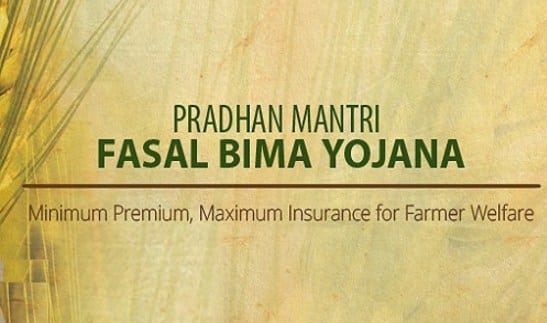Objectives of the PMFBY scheme
- To provide insurance coverage and financial support to the farmers in the event of failure of any of the notified crop as a result of natural calamities, pests & diseases.
- To stabilise the income of farmers to ensure the continuity of their farming activities.
- To encourage farmers to adopt innovative and modern agricultural practices.
- To ensure the flow of credit to the agriculture sector.
Highlights of the scheme
- The Pradhan Mantri Fasal Bima Yojana will help reduce the burden of premiums on farmers who take loans for farming activities and will also safeguard them against unfavourable weather conditions.
- The budgetary allocation for the scheme presented in the budget 2016-2017 was Rs.5, 550 cores.
- The settlement process of the insurance claim will be made fast and easy so that the farmers do not face any trouble regarding the crop insurance plan.
Also Read: Civil Service Exam (Mains: GS-1)- Syllabus
- This scheme will be implemented in every state of India, in association with their respective State Governments.
- It will be administered by the Ministry of Agriculture and Farmers Welfare, Government of India.
- The insurance plan will be handled by a single insurance company, Agriculture Insurance Company of India (AIC).
- The PMFBY is a replacement scheme of National Agriculture Insurance Scheme (NAIS) and Modified National Agriculture Insurance Scheme (MNAIS) and hence it is exempted from service tax.What are the premium rates?
- Farmers will have to pay a uniform premium of only 2% for all Kharif crops and 1.5% for all Rabi crops.
- In the case of annual commercial and horticultural crops, the premium to be paid by farmers will be only 5%.
- The premium rates are very low and the balance premium will be paid by the Government to provide the full insured amount to the farmers against crop loss caused due to natural calamities.
Also Read: SMART CITY MISSION (Part-2)
- No upper limit has been fixed on this Government subsidy. Even if the balance premium is 90%, it will be borne by the Government.
- Earlier, there was a provision of capping the premium rate which meant low claims being paid to farmers. This condition has been removed now and farmers will get the claim against their full sum insured without any reduction.
Leveraging technology
- The use of technology will be encouraged to a great extent.
- Smartphones, Remote sensing drone and GPS technologies will be used to capture and upload data of crop cutting to reduce any delays in the payment of claims.
Also Read: Rising India- An emerging economic powerhouse
Covers under the scheme
1. Coverage of the farmers:
- All farmers including sharecroppers and tenant farmers growing the notified crops in the notified areas are eligible for coverage.
- The non-loanee farmers are required to submit necessary documentary evidence of land records prevailing in the State Records of Right (RoR), Land possession Certificate (LPC) etc. moreover, applicable contract, agreement details, other documents notified permitted by concerned State Government.
- All farmers availing Seasonal Agricultural Operations (SAO) loans from Financial Institutions (i.e. loanee farmers) for the notified crops would be covered compulsorily.
- The Scheme would be optional for the non-loanee farmers.
- Special efforts shall be made to ensure maximum coverage of SC/ ST/ Women farmers under the scheme.
- Budget allocation and utilisation under this should be in the proportion of land holding of SC/ ST/ General along with Women in the respective state cluster.
- Panchayat Raj Institutions (PRIs) may be involved in the implementation and also obtaining framers feedbacks on these crop insurance schemes.
Also Read: Next Generation Infrastructure for New India
2. Coverage of the crops:
- Food Crops (Cereals, Millets and Pulses)
- Oilseeds
- Annual Commercial / Annual Horticultural crops
3. Coverage of the Risk:
Following stages of the crop and risks leading to crop loss are covered under the Scheme.
- Prevented Sowing/ Planting Risk: Insured area is prevented from sowing planting due to deficit rainfall or adverse seasonal Conditions.
- Standing Crop (Sowing to Harvesting): Comprehensive risk insurance is provided to cover yield losses due to non-preventable risks, viz. Drought, Dry spells, Flood, Inundation, Pests and Diseases, Landslides, Natural Fire and Lightning, Storm, Hailstorm, Cyclone, Typhoon, Tempest, Hurricane and Tornado.
- Post-Harvest Losses: Coverage is available only up to a maximum period of two weeks from harvesting for those crops which are allowed to dry in cut and spread condition in the field after harvesting against specific perils of a cyclone and cyclonic rains and unseasonal rains.
- Localised Calamities: Loss/ damage resulting from the occurrence of identified localised risks of hailstorm, landslide, and inundation affecting isolated farms in the notified area.
4. Exclusion of the Risk
The insurance cover will not be applicable in the case of damage to crops due to any of the following reasons.
- War & kindred perils
- Nuclear risks
- Riots
- Malicious damage
- Theft or act of enmity
- Grazed and/or destroyed by domestic and/or wild animals and other preventable risks shall be excluded.
Read in Hindi: Pradhan Mantri Fasal Beema Yojana in Hindi (PMFBY)
5. Sum Insured/Limits of Coverage
- In the case of Loanee farmers under Compulsory Component, the Sum Insured would be equal to Scale of Finance for that crop as fixed by District Level Technical Committee (DLTC) which may extend up to the value of the Threshold Yield of the insured crop at the option of insured farmer. The value of the threshold yield is lower than the Scale of Finance; higher amount shall be the Sum Insured.
Also Read: Budget Merger – Doing Away with Colonial Legacy
- Multiplying the National Threshold Yield with the Minimum Support Price (MSP) of the current year arrives at the value of sum insured. Wherever, Current year’s MSP is not available, so previous years MSP shall be adopted.
- The crops for which, MSP is not declared, farm gate price established by the marketing department board shall be adopted.
Management and Monitoring of the scheme
- The existing State Level Co-ordination Committee on Crop Insurance (SLCCCI), of the concerned State, will be responsible for monitoring the scheme.
- However, a National Level Monitoring Committee (NLMC) under the chairmanship of Joint Secretary (Credit), Department of Agriculture cooperation and farmers welfare (DAC & FW) will monitor the scheme at the national level.
- Moreover, District Level Monitoring Committee (DLMC) already overseeing the implementation & monitoring of the ongoing crop insurance schemes like National Agricultural Insurance Scheme (NAIS), Weather Based Crop Insurance Scheme (WBCIS), Modified National Agricultural Insurance Scheme (MNAIS) and Coconut Palm Insurance Scheme (CPIS) shall be responsible for the proper management of the Scheme.
Also Read: Bad Bank & Associated Issues: The Hindu Editorial Rejigged
Exclusive web portal and mobile app
- The Government of India has recently launched an Insurance portal for better administration, coordination, proper dissemination of the information and transparency for the framers.
- An Android-based “Crop Insurance App” has also been launched which could be downloaded from the website of Crop Insurance, Department of Agriculture cooperation and farmers welfare (DAC & FW).
Note: Want to share this story with someone? Just click on the icons below.











